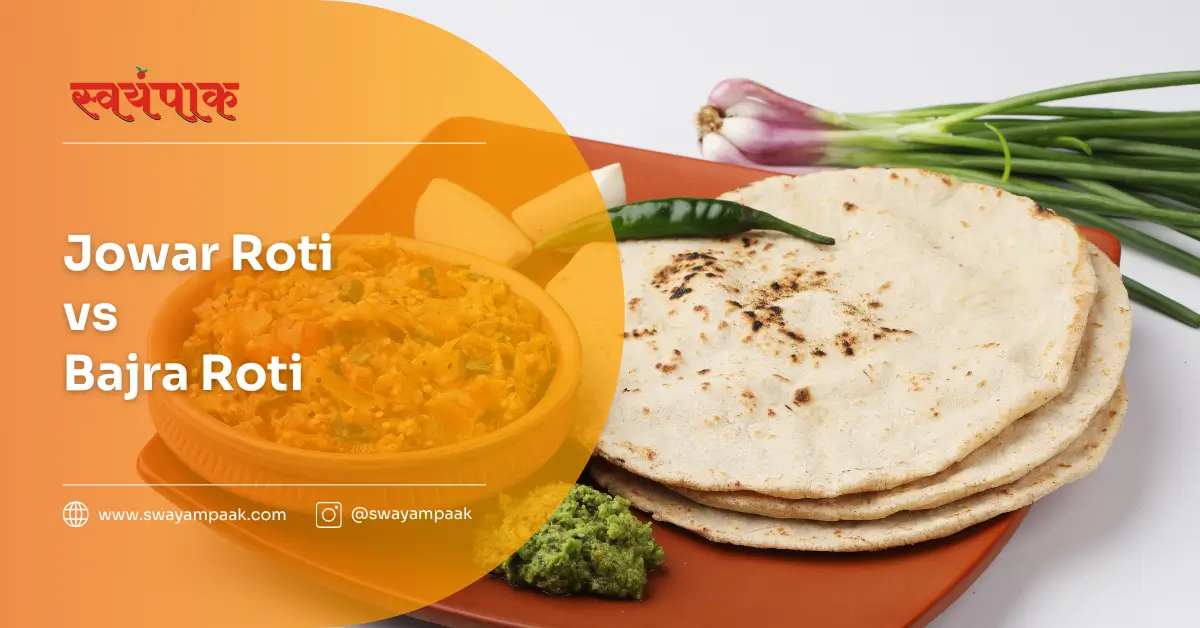If you are familiar with Maharashtrian cuisine or even Indian cuisine, you would have heard of the two basic grains i.e. Jowar (Sorghum) and Bajra (Pearl Millet). These two are the healthiest and gluten-free substitutes for regular Wheat flour.
So, if we ask to compare Jowar Roti vs Bajra Roti, the Indian audience will tell you the word “BHAAKAR” i.e. the roti made from these two grains.
Roti, a staple food in Indian cuisine, is a flatbread made from whole wheat flour. While wheat roti is the most common type, many other varieties are made from different grains, each with unique flavour, texture, and nutritional benefits. Two such varieties are Jowar roti and Bajra roti, which are made from Jowar and Bajra flour.
In this article ‘Jowar Roti vs Bajra Roti’, we will delve into the differences between Jowar roti and Bajra roti, exploring their nutritional value, flavour profiles, and common uses. By understanding their unique characteristics, you can make informed choices when incorporating these healthy flatbreads into your diet.
Key Takeaways from the article Jowar Roti vs Bajra Roti.
- They offer a variety of health benefits, including fibre, protein, vitamins, and minerals.
- They are suitable options for individuals with gluten sensitivities or celiac disease.
- Jowar roti has a slightly nutty flavour and a chewy texture, while Bajra roti has a denser and more hearty texture.
- Both rotis are made by grinding flour into a dough and cooking it on a griddle.
- Both can be enjoyed as a side dish, used in sandwiches or wraps, or incorporated into various recipes.
- Both offer benefits for digestion, weight management, blood sugar control, and overall health.
- The best roti for you depends on your taste preferences and dietary needs.
The Versatile Roti
Roti, a flatbread made from whole wheat flour, is a staple food in Indian cuisine. It is a versatile ingredient that can be enjoyed on its own or as an accompaniment to various dishes. While wheat roti is the most common type, many other varieties are made from different grains, each with unique flavour, texture, and nutritional benefits.
This blog post aims to explore the key differences between Jowar roti and Bajra roti, two popular alternatives to wheat roti. By understanding their unique characteristics, you can make informed choices when selecting the best type of roti for your dietary needs and preferences. We will compare their nutritional profiles, flavour profiles, and common uses to help you decide which roti is the right fit for you.
Jowar Roti: A Nutritious and Versatile Flatbread
What is Jowar?
Jowar, also known as sorghum, is a millet grain native to Africa. It is a versatile grain that has been cultivated for thousands of years and is widely used in Indian cuisine. Jowar is a gluten-free grain, making it a suitable option for those with gluten sensitivities or celiac disease.
Nutritional Benefits of Jowar
Jowar is a nutrient-dense grain that offers several health benefits: Jowar is high in dietary fibre, which aids digestion, promotes satiety, and can help regulate blood sugar levels. Jowar contains a moderate amount of protein, making it a valuable option for vegetarians and vegans. Jowar is a good source of vitamins like B vitamins and minerals such as iron, magnesium, and zinc. Jowar is a natural gluten-free grain, making it a suitable option for those with gluten sensitivities or celiac disease. Jowar roti is made by grinding jowar flour into a dough and cooking it on a tawa (griddle) or skillet. The process is similar to making traditional wheat roti.
The Flavour and Texture of Jowar Roti
Jowar roti has a slightly nutty flavour and a chewy texture. It is often described as having a denser and more hearty texture compared to wheat roti.
Common Uses of Jowar Roti in Indian Cuisine
Jowar roti is a versatile flatbread that can be enjoyed in various ways. It is often served as a side dish with curries, stews, and vegetables. Jowar roti can also be used to make sandwiches or wraps.
Bajra Roti: A Nutritious and Hearty Flatbread
What is Bajra?
Bajra, also known as pearl millet, is a gluten-free grain that is widely cultivated in India and other parts of the world. It is a nutritious grain that has been used in traditional Indian cuisine for centuries.
Nutritional Benefits of Bajra
Bajra is a nutritionally dense grain that offers several health benefits. Bajra is rich in dietary fibre, which aids digestion, promotes satiety, and can help regulate blood sugar levels. Bajra contains a moderate amount of protein, making it a valuable option for vegetarians and vegans. Bajra is a good source of vitamins like B vitamins and minerals such as iron, magnesium, and zinc. Bajra is a naturally gluten-free grain, making it a suitable option for those with gluten sensitivities or celiac disease.
How to Make Bajra Roti
Bajra roti is made by grinding Bajra flour into a dough and cooking it on a tawa (griddle) or skillet. The process is similar to making traditional wheat roti.
The Flavour and Texture of Bajra Roti
Bajra roti has a slightly nutty flavour and a chewy texture. It is often described as having a denser and more hearty texture compared to wheat roti.
Common Uses of Bajra Roti in Indian Cuisine
Bajra roti is a versatile flatbread that can be enjoyed in various ways. It is often served as a side dish with curries, stews, and vegetables. Bajra roti can also be used to make sandwiches or wraps.
Jowar Roti vs Bajra Roti: A Comparison
| Nutrient | Jowar (Sorghum) | Bajra (Pearl Millet) |
|---|---|---|
| Energy (kcal) | 349 | 378 |
| Carbohydrates (g) | 72.6 | 67.5 |
| Protein (g) | 10.4 | 11.6 |
| Fat (g) | 3.1 | 5.0 |
| Fibre (g) | 6.7 | 8.5 |
| Iron (mg) | 4.1 | 8.0 |
| Calcium (mg) | 25 | 42 |
Key Differences in Nutritional Value
Both Jowar and Bajra are nutritious grains, but they have slightly different nutritional profiles. Jowar is generally higher in fibre and iron, while Bajra is slightly higher in protein. Both grains are good sources of B vitamins, magnesium, and zinc.
Flavour and Texture Comparison
Jowar roti and Bajra roti have similar textures, both being chewy and slightly dense. However, there is a slight difference in flavour. Jowar roti has a slightly nutty flavour, while Bajra roti may have a slightly bitter taste, especially if it is not cooked properly.
Cooking Methods and Techniques
The cooking methods for Jowar roti and Bajra roti are similar. Both are made by grinding the flour into a dough and cooking it on a tawa (griddle) or skillet. The technique involves rolling out the dough into thin circles and cooking them over a hot griddle until they are golden brown on both sides.
Common Uses and Versatility
Both Jowar roti and Bajra roti are versatile flatbreads that can be enjoyed in various ways. They are commonly served as a side dish with curries, stews, and vegetables. They can also be used to make sandwiches, wraps, or even as a base for pizza. Both types of roti can be enjoyed by people with gluten sensitivities or celiac disease, as they are gluten-free.
Health Benefits of Jowar and Bajra
Fiber Content and Digestive Health
Both Jowar and Bajra are rich in dietary fibre, which is essential for digestive health. Fiber helps to regulate bowel movements, prevents constipation, and promotes satiety. The fibre in Jowar and Bajra can also help to lower cholesterol levels and improve blood sugar control.
Protein Content and Muscle Building
Jowar and Bajra are both good sources of protein, making them valuable options for vegetarians and vegans. Protein is essential for building and repairing tissues, including muscles. Consuming Jowar and Bajra roti can help support muscle growth and recovery.
Vitamin and Mineral Content
Jowar and Bajra are packed with essential vitamins and minerals. They are good sources of B vitamins, iron, magnesium, and zinc. These nutrients play important roles in various bodily functions, including energy production, immune function, and bone health.
Blood Sugar Control
The fibre content in Jowar and Bajra can help regulate blood sugar levels. Fibre slows down the absorption of glucose, preventing spikes and drops in blood sugar. This can be beneficial for individuals with diabetes or those looking to maintain healthy blood sugar levels.
Weight Management
Jowar and Bajra are both low in calories and high in fibre, making them excellent choices for weight management. The fibre content helps you feel full and satisfied, reducing the likelihood of overeating. Additionally, the protein in these grains can help boost metabolism and support weight loss efforts.
Choosing the Right Roti for You: Jowar Roti vs Bajra Roti
Factors to Consider
When choosing between Jowar roti and Bajra roti, consider the following factors:
- Health goals: If you are looking to increase your fibre intake, improve digestion, or manage blood sugar levels, both Jowar and Bajra roti are excellent options.
- Dietary restrictions: Both Jowar and Bajra are gluten-free grains, making them suitable for individuals with gluten sensitivities or celiac disease.
- Personal preferences: Ultimately, the best roti for you is the one that you enjoy eating the most. Taste and texture can vary, so it’s worth trying both to see which you prefer.
Incorporating Jowar and Bajra Roti into Your Diet
There are many ways to incorporate Jowar and Bajra roti into your diet. Here are a few ideas:
- Serve as a side dish: Jowar and Bajra roti can be served as a side dish with curries, stews, and vegetables.
- Make sandwiches or wraps: Use Jowar or Bajra roti as a base for sandwiches or wraps.
- Enjoy as a snack: Jowar and Bajra roti can be enjoyed on their own as a healthy snack.
- Experiment with different recipes: There are many creative ways to use Jowar and Bajra roti in your cooking. Try them in different dishes to discover your favourite combinations.
Recipe Ideas
- Jowar and Bajra roti with vegetable curry
- Stuffed Jowar or Bajra roti with paneer or potatoes
- Jowar or Bajra roti pizza
- Jowar or Bajra roti tacos
- Jowar or Bajra roti sandwiches with hummus and vegetables
Tips for Making Delicious and Healthy Rotis
- Fresh ingredients: Use fresh Jowar or Bajra flour to ensure the best flavour and texture.
- Proper kneading: Knead the dough until it becomes smooth and elastic.
- Cooking technique: Cook the rotis on a hot griddle or skillet until they are golden brown on both sides.
- Experiment with fillings: Try different fillings for your rotis, such as vegetables, paneer, or potatoes.
- Storage: Store leftover rotis in an airtight container in the refrigerator.
Conclusion
Both Jowar roti and Bajra roti are nutritious and versatile flatbreads that offer a variety of health benefits. Jowar roti has a slightly nutty flavour and a chewy texture, while Bajra roti has a denser and more hearty texture. Both are gluten-free and packed with fibre, protein, vitamins, and minerals.
We encourage you to experiment with both Jowar roti and Bajra roti to discover your personal preferences. Both types of roti can be enjoyed in various ways, from serving as a side dish to being used in sandwiches or wraps. By incorporating these healthy flatbreads into your diet, you can benefit from their nutritional value and enjoy their delicious taste.



